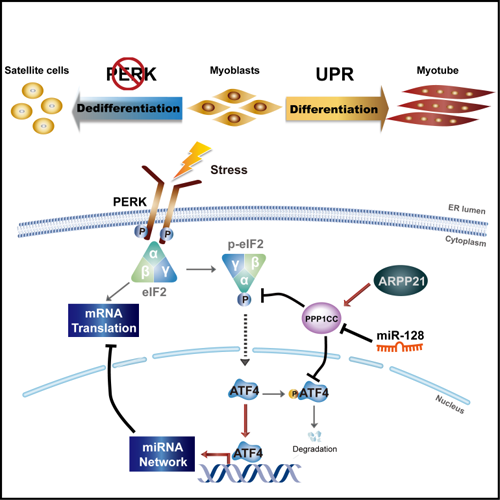Professor Liang-Hu Qu’s group: “PERK Signaling Controls Myoblast Differentiation by Regulating MicroRNA Networks”
Source: School of Life Sciences
Edited by: Tan Rongyu, Wang Dongmei
The unfolded protein response (UPR) is an evolutionarily conserved signalling pathway that responds to perturbations in endoplasmic reticulum (ER) homeostasis. The UPR is known to be mediated by three ER transmembrane sensors: the RNA-dependent protein kinase-like ER eukaryotic translation initiation factor 2 alpha kinase (PERK), inositol-requiring enzyme 1 (IRE1), and activating transcription factor 6 (ATF6). The UPR plays crucial roles in physiological and pathological processes, and has been found to be tightly associated with the differentiation of some stem cells and embryonal organs; however, its underlying mechanism in developmental processes remains to be elucidated. Recently, Professor Liang-Hu Qu’s group (School of Life Sciences, Sun Yat-sen University) reports a new mechanism underlying PERK,one branch of the UPR as a major regulator of miRNA networks in myoblast differentiation and fate determination.
In this study, the group separately knocked down the three sensors of the UPR in C2C12 myoblasts and found that loss of any UPR sensor led to a defect in the process of cell fusion and myotube formation. Especially, loss of Perk not only prevented the expression of differentiation markers completely, but also led to a marked transformation in myoblasts from a fusiform to a rounded morphology. Interestingly, knocking down Perk induced reprogramming of C2C12 myoblasts into myogenic satellite cells by altering the miRNA networks associated with differentiation and stemness maintenance, and the PERK-ATF4 signalling pathway transactivated muscle differentiation-associated miR-1a and miR-133a in the early stage of myoblast differentiation. Furthermore, this study identified Ppp1cc as a direct target gene of miR-128 regulated by the PERK signalling pathway and showed that its repression is critical for a positive feedback loop that regulates the activity of UPR-associated signalling pathways, leading to cell migration, cell fusion, endoplasmic reticulum expansion, and myotube formation during the differentiation of myoblasts. Subsequently, they found that the RNA binding protein ARPP21, encoded by the host gene of miR-128-2, antagonized miR-128 activity by competing with it for binding to the 3’ untranslated region (UTR) of Ppp1cc to maintain the cell homeostasis during myogenesis.

Together, this study reveals the crucial function and mechanism of PERK signalling in myoblast maintenance and differentiation, and expands our understanding of the role of the UPR in stem cell differentiation and fate determination. Meanwhile, the discovery that myoblasts can be induced into myogenic satellite cells by knocking down Perk provides us a new idea and technology for cell reprogramming in vitro.
This work is recently published in
Front Cell Dev Biol, the title is “PERK Signaling Controls Myoblast Differentiation by Regulating MicroRNA Networks”. Professor Lianghu Qu (Sun Yat-sen University) and Associate Professor Lingling Zheng (Sun Yat-sen University) are co-corresponding authors of this paper. Doctoral Yeya Tan and assistant researcher Yin Zhang (Sun Yat-sen Memorial Hospital) are co-first authors of this paper. This work was supported by the Major Research Program of the National Natural Science Foundation of China (NSFC).
Link to the paper:
https://doi.org/10.3389/fcell.2021.670435
